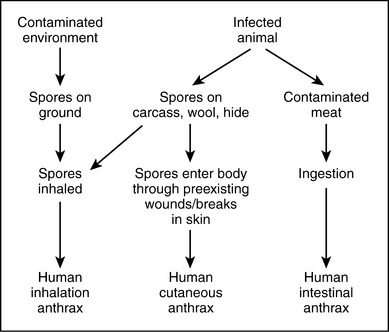ANTHRAX
Anthrax occurs worldwide. It is usually seen in areas where animals have died from anthrax and contaminated the soil with spores. Outbreaks of anthrax are most often associated with warm weather seasons, heavy rains, and/or droughts.
TRANSMISSION
Humans are infected by ingestion or inhalation of anthrax spores or by handling contaminated carcasses, wool, hide, or hair (Figure 1). When a person is infected through handling a contaminated object, the spores enter through preexisting skin cuts or abrasions. Direct person-to-person spread of anthrax is extremely rare. Communicability is not a concern in managing or visiting with patients with inhalational anthrax.
In animals, the most common form of transmission is ingestion of anthrax spores. The spores in the soil are ingested when environmental conditions are right. Periods of heavy rain can wash the spores into low-lying areas, where they are exposed to oxygen as they are brought to the surface, and animals grazing in these areas ingest the spores. Drought conditions, in which pastures have little plant growth, can also be a contributing factor. Animals graze closer to the ground than they normally would and may ingest spores. Biting flies can, but rarely do, transmit B. anthracis from one animal to another. Outbreaks in pigs have been associated with feed containing meat and/or bone meal from infected carcasses. Wild animals or other scavengers become infected by feeding on infected dead animals.




